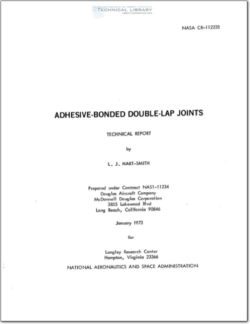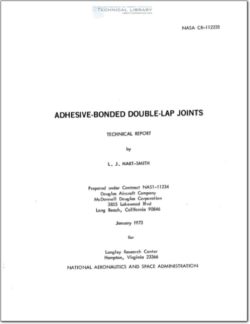NASA-CR-112235

- Version
- 311 Downloads
- 3.20 MB File Size
- 1 File Count
- December 13, 2015 Create Date
- December 13, 2015 Last Updated
Adhesive Bonded Double Lap Joints

SUMMARY
This report covers the analysis of adhesive-bonded double-lap joints by means
of elastic-plastic analytical techniques. Explicit solutions are derived. The
classical elastic analysis by Volkersen, which accounted for only adherend
stiffness imbalance, is extended to include adhesive plasticity and adherend
thermal mismatch. The formulas derived are sufficiently simple for design use,
yet account for more parameters than have been included in previous published
analyses.
Three important characteristics of double-lap joints are deduced. The first is
that there is a definite limit to the bond strength developable between specif-
ied adherends for a particular adhesive. The load capacity increases with over-
lap only until a defined value is attained. Beyond that overlap, no greater
load transfer can be effected. The load transfer is confined to two end zones
(only one in the case of severely dissimilar adherends) with a lightly-loaded
elastic trough in between. The extent of these end zones is limited and
expressed independently of the total overlap.
The second inherent characteristic of double-lap joints is that the maximum
potential bond shear strength is determined by the adhesive strain energy in
shear per unit bond area. This single adhesive parameter is the necessary and
sufficient characterization. That this is so has been established in terms of
a bi—elastic adhesive analysis in which it was demonstrated that all such
adhesive characterizations (two straight lines) having the same strain energy
(area under the stress—strain curve) and same failure stress and strain develop
precisely the same maximum bond strength between the same adherends. The
precise shape of the stress-strain curve has no effect on the limiting joint
strength. The shape can affect only the adhesive shear stress distribution
along the overlap.
The third feature of this analysis is that it shows precisely how much more of
a problem are the adhesive peel stresses at the ends of the overlap than are
the associated shear stresses. This peel problem is acute for thick composite
adherends and imposes an effective limit on the thickness of adherends which
can be bonded efficiently by means of a uniform double-lap joint. Beyond that
thickness, it is necessary to use a more efficient tapered-lap joint, stepped—
lap joint, or scarf joint.
Joint efficiency charts are provided for common adherend materials. Because it
had not been anticipated hitherto that there was a need to characterize the
adhesive film in peel as well as in shear, portions of these charts are specul-
ative. The shear properties selected represent typical properties for the best
350 °F curing ductile and brittle (high-temperature) structural epoxy-base
adhesives available. These charts show how, for thin adherends, the potential
bond shear and peel strengths exceed by far the adherend strengths. Then, for
moderate thicknesses, the limited shear strength of the adhesive may limit the
joint strength. For thicker adherends, the limiting factor is invariably the
peel strength of the adhesive for metal adherends or the interlaminar tension
strength of the laminate for filamentary composite adherends.
| File | Action |
|---|---|
| NASA-CR-112235 Adhesive Bonded Double Lap Joints.pdf | Download |

Comment On This Post